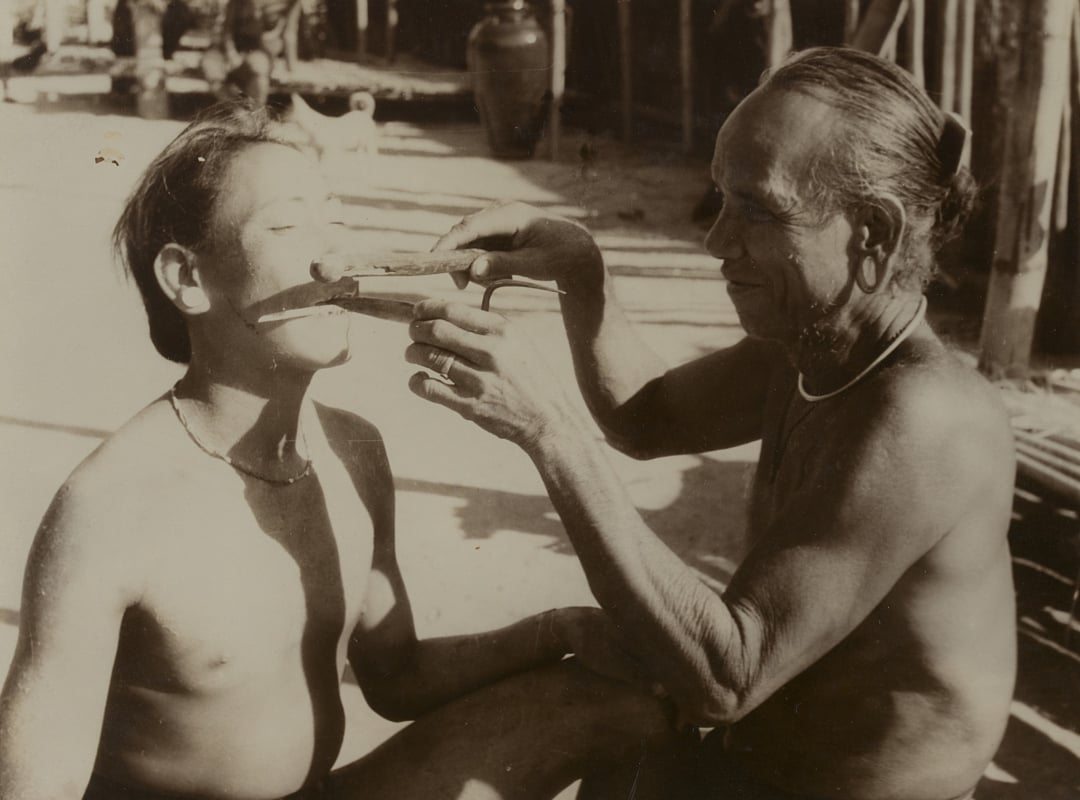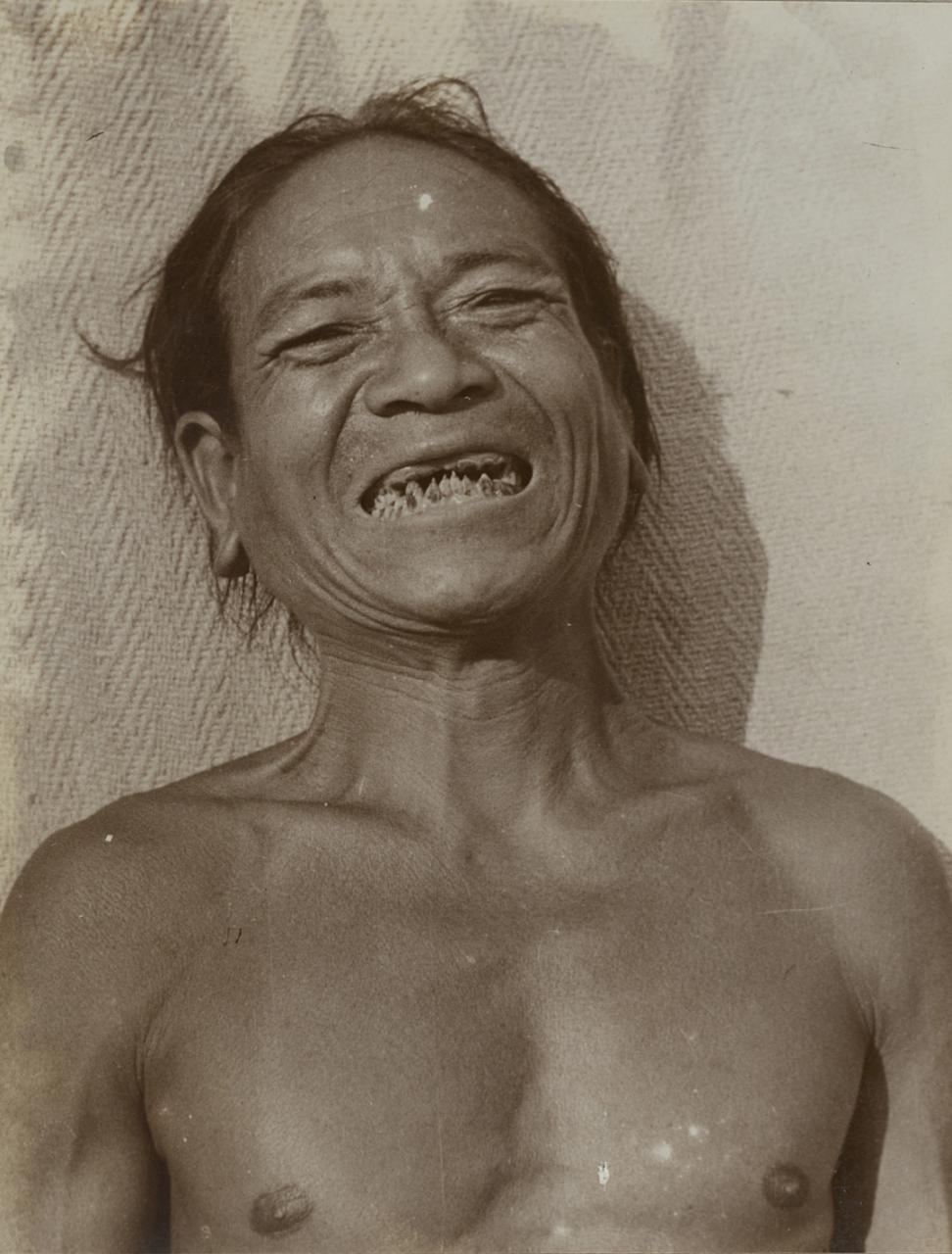08:57, October 29, 2023
In the past, ethnic groups belonging to the Mon-Khmer language line such as Co Tu, Ta Oi, M'nong, Stieng, Ma, K'ho, Bahnar, B'râu, Rmăm... residing in the Truong Son - Tay Nguyen region had the custom of scraping, sawing teeth, stretching ears...
Tooth filing, in addition to its beautifying function according to the ethnic group's concept, is also a ritual marking the transition from adolescence to adulthood. This custom has now been abolished, with only traces remaining in some elderly people. In 1948, photographer Claude Chippaux, during a field trip to a K'ho village, witnessed a tooth filing ritual and captured valuable documentary photos of this custom.
Claude Chippaux observed and described the tooth filing ritual with quite vivid and realistic photos. The scene is an ethnic village with traditional ground-floor houses of the residents of the southern Central Highlands. The two prominent central characters of the photo are the person performing the ritual and the person receiving the ritual. Both wear loincloths and leave their upper bodies bare. The person performing the ritual could be the father or a village elder with experience in tooth filing, who could be called a "tooth filing worker". He has his hair tied back, has wide ears, proving that he used to file his teeth in the past, and stretched his ears when he reached the age like all other members of the village. The person whose teeth are filed sits on a piece of wood, his face slightly raised, his mouth open and his teeth exposed. Looking at the close-up photo, it is clear that the person filing his teeth uses tools such as a saw, a whetstone, a small knife to saw and cut the teeth, along with a tool that looks like an ENT surgeon's ball!
 |
| Worker with tools for cutting, sawing and filing teeth. Photo: Claude Chippaux |
In the photo series, there is a rather unique photo of the person whose teeth are being filed lying on the ground, while the dental filer sits on his head, bending down to work. This lying position is probably easier to work in and reduces the effort and pain caused by the impact of the tools, which can injure the young man's teeth. Another photo shows a portrait of a man baring his teeth, the upper jaw close to the gums, the lower jaw has 4 sharp incisors, as if to show off his newly completed teeth.
As described in the picture, when practicing tooth filing, people have to file and cut the upper jaw so that only the roots remain close to the gums, and the lower jaw must be sharpened very sharply. They do not file and cut the entire jaw, but only sharpen the four pairs of incisors, leaving the canines and molars intact. The tooth filing and cutting is done by using a grinding stone to gradually shorten the teeth or using a sharp knife to cut each piece into thin pieces, the upper jaw teeth are filed so that the roots remain and use a stick to dig out all the pulp so that the roots have holes, and then use a knife to sharpen the lower teeth. When filing and cutting the teeth, the roots are agitated, causing a lot of bleeding, and both jaws are swollen for a whole week. During that time, the person whose teeth are filed cannot eat anything but only drink porridge. For some ethnic groups, filing and cutting teeth must be done at the right age of adulthood, when all 32 teeth have grown. But at the latest, it is done at the age of twenty before getting married. There are also people who have not filed their teeth or stretched their ears, but once they are married, they completely abandon this custom, no longer needing to file their teeth or stretch their ears, no matter who laughs at them.
The tooth that had just been filed was still injured, so people had to rinse their mouths with salt water to clean it and apply tree resin to the tooth root. The spicy taste of the tree resin and wood ash made the tooth root ache and hurt terribly, but it only lasted for a moment and then it went away. The resin stuck to the tooth, turning it a very distinctive black color. Every night before going to bed, young men and women had to practice applying tree resin regularly to their teeth, and the tooth root was never eaten away by cavities, making the tooth root stronger. Tree resin was applied only once a month, but the tooth still retained its black color.
 |
| K'ho ethnic man with freshly filed teeth. Photo: Claude Chippaux |
Some people think that eating rice after cutting the teeth tastes better. The M'nong people have funny and innocent rhymes about this custom: "If the ears are not pierced, they cannot fall down/If the teeth are not cut, they will stick out of the mouth" or: "Eels and turtles still know how to cut their teeth/Why do people laugh at me if I cut my teeth?" Whoever performs these customs early will be placed in the honorable ranks of the village and will be trusted with important and complicated tasks. Filing teeth is a must for adults, whether male or female, because it is a standard of beauty, even a strength, a good thing, affirming the ability, quality, and "posture" of an individual: "Bu jă mnuih kô tuih mẫu geh/Bu jă peh mpăl mẫu tơm/Bu jă gơm sek nôm mẫu ot (Whoever invites you to go clear the fields, say you lack a stick/Whoever invites you to pound rice, say you lack a mortar/Whoever invites you to laugh, say your teeth are not filed). That is why, in the old days, it was difficult for Ma, M'nông, S'tieng, K'ho... girls to get married if they did not file their teeth. That was also the "spiritual motivation" that encouraged young women to be more courageous when receiving the tooth filing ceremony.
Claude Chippaux's photo collection of the ritual and practice of tooth filing of the K'ho people is truly a valuable ethnographic document. It is vivid evidence describing and depicting the traditional customs of the ethnic groups in the Truong Son - Tay Nguyen region that were still preserved in the mid and late 20th century.
Tan Vinh
Source





























![[Photo] National Assembly Chairman Tran Thanh Man visits Vietnamese Heroic Mother Ta Thi Tran](https://vphoto.vietnam.vn/thumb/1200x675/vietnam/resource/IMAGE/2025/7/20/765c0bd057dd44ad83ab89fe0255b783)



































































Comment (0)